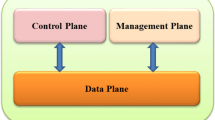Abstract
Software-defined networking (SDN) is a flexible networking paradigm that provides isolation of control and data planes from each other, proposes control mechanisms, network programmability and autonomy, and new tools for developing solutions to traditional network infrastructure problems such as latency, throughput, and packet loss losses. One of the most important critical issues that evaluated by SDN offers is the hardware and vendor-independent software for routing protocols in wireless communication. Therefore, using the SDN approach to run, manage and optimize routing algorithms efficiently has become one of the important topics. The SDN also makes it possible to use machine learning techniques for routing. In this study, a new machine learning-assisted routing (MLaR) algorithm is proposed for software-defined wireless networks. Through the trained model, this algorithm can make the most appropriate routing decision in real-time by using the historical network parameters of mobile nodes (latency, bandwidth, SNR, distance). This way, a learning the proposed routing algorithm that can adjust itself according to dynamic network conditions has been developed. The proposed MLaR algorithm is compared with the traditional Dijkstra algorithm in terms of delay and throughput ratio, and the MLaR gives more successful results. According to the simulation results, the proposed approach achieved 3.1 and 1.3 times improvement in delay and throughput, respectively, compared to the traditional Dijkstra.











Similar content being viewed by others
References
Feamster N, Rexford J, Zegura E (2014) The road to SDN: an intellectual history of programmable networks. ACM Sigcomm Comput Commun 44:87–98. https://doi.org/10.1145/2602204.2602219
Kreutz D, Ramos FMV, Verissimo PE et al (2015) Software-defined networking: a comprehensive survey. Proc IEEE 103:14–76. https://doi.org/10.1109/JPROC.2014.2371999
Cicioğlu M, Çalhan A (2020) Energy-efficient and SDN-enabled routing algorithm for wireless body area networks. Comput Commun 160:228–239. https://doi.org/10.1016/j.comcom.2020.06.003
Cicioğlu M, Çalhan A (2019) HUBsFLOW: a novel interface protocol for SDN-enabled WBANs. Comput Networks 160:105–117. https://doi.org/10.1016/j.comnet.2019.06.007
Kurose J, Keith W (2007) K. Ross Computer networking: a top down approach
Alpaydin E (2014) Introduction to Machine learning ethem Alpaydin.
Wang M, Cui Y, Wang X et al (2018) Machine learning for networking: workflow, advances and opportunities. IEEE Netw 32:92–99. https://doi.org/10.1109/MNET.2017.1700200
Ertuğrul ÖF, Tağluk ME (2017) A novel machine learning method based on generalized behavioral learning theory. Neural Comput Appl 28:3921–3939. https://doi.org/10.1007/s00521-016-2314-8
Nguyen TTT, Armitage G (2008) A survey of techniques for internet traffic classification using machine learning. IEEE Commun Surv Tutorials 10:56–76. https://doi.org/10.1109/SURV.2008.080406
Zhang J, Xiang Y, Wang Y et al (2013) Network traffic classification using correlation information. IEEE Trans Parallel Distrib Syst 24:104–117. https://doi.org/10.1109/TPDS.2012.98
Moysen J, Giupponi L (2018) From 4G to 5G: self-organized network management meets machine learning. Comput Commun 129:248–268. https://doi.org/10.1016/j.comcom.2018.07.015
Mestres A, Rodriguez-Natal A, Carner J et al (2017) Knowledge-defined networking. ACM SIGCOMM Comput Commun Rev 47:2–10. https://doi.org/10.1145/3138808.3138810
Binsahaq A, Sheltami TR, Salah K (2019) A Survey on autonomic provisioning and management of QoS in SDN networks. IEEE Access 7:73384–73435. https://doi.org/10.1109/ACCESS.2019.2919957
Luong NC, Hoang DT, Gong S et al (2019) Applications of deep reinforcement learning in communications and networking: a survey. IEEE Commun Surv Tutorials 21:3133–3174. https://doi.org/10.1109/COMST.2019.2916583
Martin I, Troia S, Hernandez JA et al (2019) Machine learning-based routing and wavelength assignment in software-defined optical networks. IEEE Trans Netw Serv Manag 16:871–883. https://doi.org/10.1109/TNSM.2019.2927867
Xie J, Yu FR, Huang T et al (2019) A survey of machine learning techniques applied to software defined networking (sdn): research issues and challenges. IEEE Commun Surv Tutorials 21:393–430. https://doi.org/10.1109/COMST.2018.2866942
Pasca STV, Kodali SSP, Kataoka K (2017). AMPS: Application aware multipath flow routing using machine learning in SDN. In: 2017 Twenty-third national conference on communications (NCC). IEEE, pp 1–6
Chen F, Zheng X (2015) Machine-learning based routing Pre-plan for SDN. Springer, Cham
Sharma DK, Dhurandher SK, Woungang I et al (2018) A machine Learning-based protocol for efficient routing in opportunistic networks. IEEE Syst J 12:2207–2213. https://doi.org/10.1109/JSYST.2016.2630923
Author information
Authors and Affiliations
Contributions
Murtaza CİCİOĞLU and Ali ÇALHAN were involved in conceptualization, methodology, software, writing—original draft, visualization, review & editing.
Corresponding author
Ethics declarations
Conflict of interest
The authors declare that they have no conflicts of interest.
Additional information
Publisher's Note
Springer Nature remains neutral with regard to jurisdictional claims in published maps and institutional affiliations.
Supplementary Information
Rights and permissions
Springer Nature or its licensor (e.g. a society or other partner) holds exclusive rights to this article under a publishing agreement with the author(s) or other rightsholder(s); author self-archiving of the accepted manuscript version of this article is solely governed by the terms of such publishing agreement and applicable law.
About this article
Cite this article
Cicioğlu, M., Çalhan, A. MLaR: machine-learning-assisted centralized link-state routing in software-defined-based wireless networks. Neural Comput & Applic 35, 5409–5420 (2023). https://doi.org/10.1007/s00521-022-07993-w
Received:
Accepted:
Published:
Issue Date:
DOI: https://doi.org/10.1007/s00521-022-07993-w




